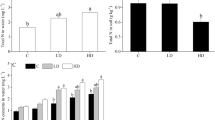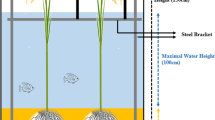Abstract
Concurrent, rice-fish systems in the Mekong Delta, Vietnam, are characterized by a rice field surrounded by a trench. Rice is direct seeded and fish are reared in polyculture. The most common species for polyculture are silver barb Barbodes gonionotus (Bleeker), common carp Cyprinus carpio L. and Nile tilapia Oreochromis niloticus (L.). In a 1996–97 rice-fish experiment, the effects of (1) absence or presence of such a polyculture, and (2) different rice-seeding rates (100 and 300 kg pre-germinated rice per ha) on the field floodwater ecology were studied. Fish obtained from local nurseries were stocked in six out of 12 rice-fish plots at the Co Do experimental rice-fish station (10°10′ N and 105°20′ E). Silver barb, common carp and Nile tilapia were stocked in polyculture at densities of 3150, 310 and 550 fish ha−1, respectively. About 50% of the observed variation in the floodwater could be attributed to the fish stocked and to rice-seeding rate. The above-ground dry weight of the rice plants increased in the presence of fish and by an increase in rice-seeding rate. Greater shading by denser plants resulted in changes in variables related to aquatic primary production, including the amount of chlorophyll-a, dissolved oxygen concentration and pH. The presence of fish quadrupled the ammonium concentration, but decreased that of ortho-phosphate. Though fish increased the ammonium concentration, this did not result in a higher aquatic photosynthesis. Light, not ammonium, was the most limiting factor. However, increased ammonium concentrations in the presence of fish did have a positive effect on the density of Euglenophyta and the amount of chlorophyll-a, though only at the lower rice-seeding rate. At the higher rice-seeding rate, light seemed to be lacking. At the lower rice-seeding rate, fish also had a significant effect on the Cladocera–Rotifera ratio. Rotifera numbers increased as fish stimulated phytoplankton. We also demonstrated that fish most probably do not reduce ammonia volatilization losses. The lower rice-seeding rate seemed better for fish production than the higher rate: at the lower rate, dissolved oxygen concentrations were higher throughout the rice cycle. In addition, the amount of chlorophyll-a and the density of Euglenophyta were higher at the lower rice-seeding rate. Finally, we could show that even at high rice-seeding rates, fish had an impact on the aquatic environment. Fish access to the field is not hindered by dense rice stands.
Similar content being viewed by others
References
Cagauan, A. G., 1995. Overview of the potential roles of pisciculture on pest and disease control and nutrient management in rice fields. In Symoens, J. J. & J. C. Micha (eds), TheManagement of Integrated Freshwater Agro-piscicultural Ecosystems in Tropical Areas. RAOS & CTA, Wageningen: 203–244.
Cole, B. A. & C. E. Boyd, 1986. Feeding rate, water quality and channel catfish production in ponds. Progress in fish-culture 48: 25–29.
De Datta, S. K., I. R. P. Fillery & E. T. Craswell, 1983. Results from recent studies on nitrogen fertilizer efficiency in wetland rice. Outlook on agriculture 12: 125–134.
De Datta, S. K. & P. Nantasomsaran, 1991. Status and prospects of direct seeded flooded rice in tropical Asia. In IRRI (ed.), Direct Seeded Flooded Rice in the Tropics. IRRI, Manila: 1–16.
Delincé, G., 1992. The ecology of the fish pond ecosystems, with special reference to Africa. Developments in Hydrobiology 72. Kluwer Academic Publishers, Dordrecht, The Netherlands0: 230 pp.
Erguiza, A., B. Duff & C. Khan, 1990. Choice of rice crop establishment technique: transplanting vs wet seeding. IRRI research paper series 139. IRRI, Manila.
Fedoruk, A. & W. Leelapatra, 1992. Ricefiled fisheries in Thailand. In Dela Cruz, C. R., C. Lightfoot, B. A. Costa-Pierce, V. R. Carangal & M. P. Bimbao (eds), Rice-fish Research and Development in Asia. International Center for Living Aquatic Resource Management Conference Proceedings 24, International Center for Living Aquatic Resource Management, Manila: 91–104.
Halwart, M., 1991. Concurrent rice-fish trials: comparing regular and border planting patterns. Aquabyte 4: 2–3.
Halwart, M., 1995. Fish as biocontrol agents in rice. The potential of common carp Cyprinus carpio (L.) and Nile tilapia Oreochromis niloticus (L.). Tropical agroecology 8. Margraf Verlag, Weikersheim: 169 pp.
Halwart, M., M. Borlinghaus & G. Kaule, 1996. Activity pattern of fish in rice fields. Aquaculture 145: 159–170.
Heckman, C.W., 1979. Rice field ecology in Northeastern Thailand: the effect of wet and dry seasons on a cultivated aquatic ecosystem. Monographiae Biologicae vol 34. Junk publishers, The Hague: 228 pp.
Ho, S. C., 1980. On the chemistry of algal growth of the surface water of the Muda irrigation scheme in West Malaysia. In Furtado J. I. (ed.), Tropical Ecology and Development. Kuala Lumpur. 2: 989–998.
Hung, N. N., U. Singh, V. T. Xuan, R. J. Buresh, J. L. Padilla, T.T. Lap & T. T. Nga, 1995. Improving nitrogen-use efficiency of direct-seeded rice on alluvial soils of the Mekong River Delta. In Denning, G. L. & V. T. Xuan (eds), Vietnam and IRRI: A Partnership in Rice Research. IRRI, Manila: 137–149.
Jolliffe, I. T., 1972. Discarding variables in a principal component analysis 1: artificial data. Applied statistics 21: 160–173.
Kurasawa, H., 1956. The weekly succession in the standing crop of plankton and zoobenthos in the paddy field. Parts 1 & 2. Miscellaneous reports of the research institute for Natural Resources (Tokyo). Vol. 4(41/42): 86–98 and Vol. 4 (45): 73–84 (in Japanese).
Li, K., 1988. Rice-fish culture in China: a review. Aquaculture 71: 173–186.
Lightfoot, C. A., A. Van Dam & B. A. Costa-Pierce, 1992. What's happening to the rice yields in rice-fish systems? In Dela Cruz, C. R., C. Lightfoot, B. A. Costa-Pierce, V. R. Carangal & M. P. Bimbao (eds), Rice-fish Research and Development in Asia. International Center for Living Aquatic Resource Management Conference Proceedings 24, International Center for Living Aquatic Resource Management, Manila: 177–183.
Lightfoot, C., P. A. Roger, A. G. Cagauan & C. R. Dela Cruz, 1993. Preliminary steady-state nitrogen models of a wetland ricefield ecosystem with and without fish. In Christensen, V. & D. Pauly (eds), Trophic Models of Aquatic Ecosystems. ICLARM Conf. Proc. 26: 56–64.
Little, D. & J. Muir, 1987. A Guide to Integrated Warm Water Aquaculture. Institute of Aquaculture Publications. University of Stirling: 238 pp.
Mazumder, A., D. J. McQueen, W. D. Taylor, D. R. S. Lean & M. D. Dickman, 1990. Micro-en mesoplankton grazing on natural pico-and nanoplankton in contrasting plankton communities produced by planktivore manipulation and fertilization. Hydrobiologia 118: 257–282.
Milstein, A. & F. Svirsky, 1996. Effect of fish species combinations on water chemistry and plankton composition in earthen fish ponds. Aquaculture Res. 27: 79–90.
Nhan, D. K., L. T. Duong & A. Rothuis, 1998. Rice-fish farming systems research in the Vietnamese Mekong Delta: identification of constraints. NAGA 20: 107–111.
Parker, N. C. & K. B. Davis, 1981. Requirements of warm water fish. In Allen L. J. & E. C. Kinney (eds), Proceedings of the Bio-engineering Symposium for Fish Culture. FCS Publ. 1. Fish culture section of the American fisheries Society. Maryland: 21–28.
Roger, P. A. & S. A. Kulasooriya, 1980. Blue-green Algae and Rice. IRRI, Los Banos, Laguna: 112 pp.
Rothuis, A. J., 1998. Rice-fish culture in the Mekong Delta, Vietnam: constraint analysis and adaptive research. Ph.D. thesis, Katholieke Universiteit Leuven, Belgium: 108 pp.
Rothuis, A. J., D. K. Nhan, C. J. J. Richter & F. Ollevier, 1998. Rice with fish culture in the semi-deep water of the Mekong Delta, Vietnam: interaction of rice culture and fish husbandry management on fish production. Aquaculture Res. 29, 59–66.
Rothuis, A. J., N. Vromant, V. T. Xuan, C. J. J. Richter & F. Ollevier, 1999. The effect of rice seeding rate on rice and fish production, and weed abundance in direct-seeded rice-fish culture. Aquaculture 172: 255–274.
Saito, M. & I. Watanabe, 1978. Organic matter production in rice field flood water. Soil Sci. Plant Nutrition 24: 427–440.
Swingle, H. S., 1969. Methods of analysis for water, organic matter and pond bottom soils used in fisheries research. Auburn University, Auburn, Alabama, U.S.A.: 119 pp.
Taylor, S. R., B. Pakdee & D. Klampratum, 1988. Border method and fish culture: synergetic effects on the yield of rice grain. In Pullin, R. S. V., T. Bhukaswan, K. Tonguthai & J. L. Maclean (eds), The Second International Symposium on Tilapia in Aquaculture. ICLARM Conference Proceedings 15. Department of Fisheries, Bangkok & ICLARM, Manila: 91–98.
Vromant, N., A. J. Rothuis, N. T. T. Cuc & F. Ollevier, 1998. The effect of fish on the abundance of the rice caseworm Nymphula depunctalis (Guenée) (Lepidoptera: Pyralidae) in direct seeded, concurrent rice-fish fields. Biocontrol Sci. Technol. 8: 539–546.
Watanabe, I. & P. A. Roger, 1985. Ecology of flooded ricefields. In Wetland soils: characterization, classification and utilization. IRRI, Manila: 229–243.
Author information
Authors and Affiliations
Rights and permissions
About this article
Cite this article
Vromant, N., Chau, N.T. & Ollevier, F. The effect of rice seeding rate and fish stocking on the floodwater ecology of the rice field in direct-seeded, concurrent rice-fish systems. Hydrobiologia 445, 151–164 (2001). https://doi.org/10.1023/A:1017509514555
Issue Date:
DOI: https://doi.org/10.1023/A:1017509514555




